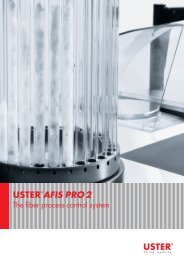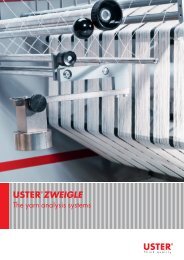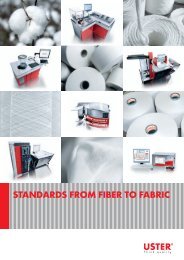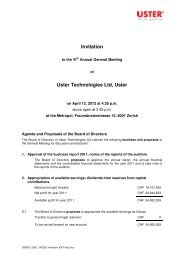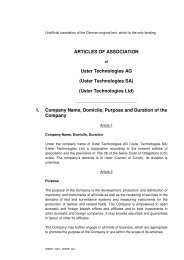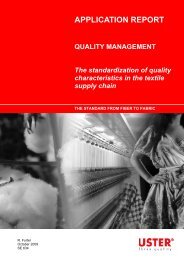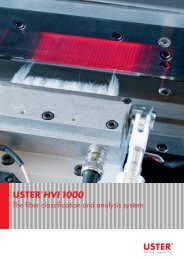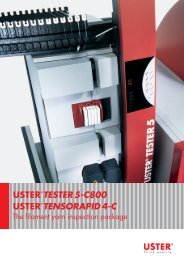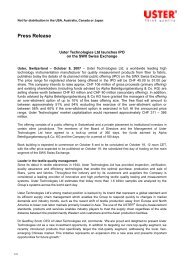Application Handbook_Uster_Statistics - Uster Technologies
Application Handbook_Uster_Statistics - Uster Technologies
Application Handbook_Uster_Statistics - Uster Technologies
- No tags were found...
Create successful ePaper yourself
Turn your PDF publications into a flip-book with our unique Google optimized e-Paper software.
4.5.6 Yarn twist with USTER ® ZWEIGLE TWIST TESTERThe amount of twist placed in a staple spun yarn is important from a technical viewpoint because ofits effect on physical properties and performance, and on finished product appearance. It has aneffect on fabric luster, hand, weight and strength. It is also important from a production standpointbecause with every turn of twist there is an accompanying reduction in productivity and an increase incost.There are two possible twist directions, Z and S. Yarns twisted clockwise have S-twist, yarns twistedcounter-clockwise have Z-twist. Most yarns worldwide have Z-twist.Usually, the twist of a yarn is given in turns per meter or turns per inch, respectively. The amount oftwist is determined mostly by the end use, and by the type and length of the fibers used.The twist of a yarn can be described by the twist per unit length (per meter or per inch), and by thetwist multiplier. Another decisive parameter for the twist characteristic of a yarn is the variation of thetwist, which should be kept within narrow limits.Absolute twistThe absolute twist is the amount of twist per meter or twist per inch, respectively. In general, one cansay that within certain limits a yarn with a higher twist is stronger than the same yarn with a lowertwist. Also, the yarn with the lower twist has a larger diameter.The conversion of turns per meter into turns per inch can be done according to the following formula:Turns per inch = Turns per meter / 39.37 = Turns per meter x 0.0254Turns per meter = Turns per inch x 39.37Twist multiplierThe most common term used to express a twist level is the twist multiplier as it is independent of theyarn count. It is used for the comparison of certain yarn characteristics of yarns with different counts.A finer yarn, e.g. needs more twist in order to reach the same character as a coarse one.The following formula shows the calculation for the twist multiplier:English twist multiplier: α e = turns per inch / NeMetric twist multiplier: α m = turns per meter / NmCharacteristics Abbreviation Unit DescriptionTwist T/m or TPI 1/m or 1/inch Twist of the yarn per meter or twist of the yarn per inchCoefficient of variation CV T % Coefficient of variation of the twist valueTable 4-20USTER ® STATISTICS 29 (36)




